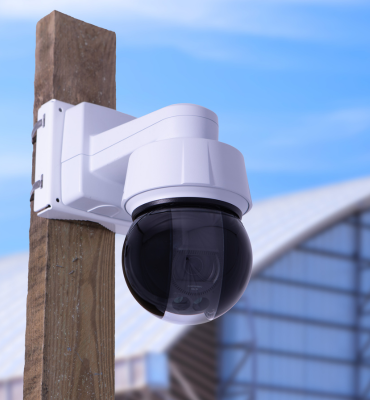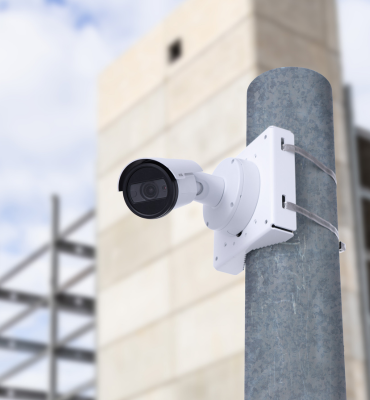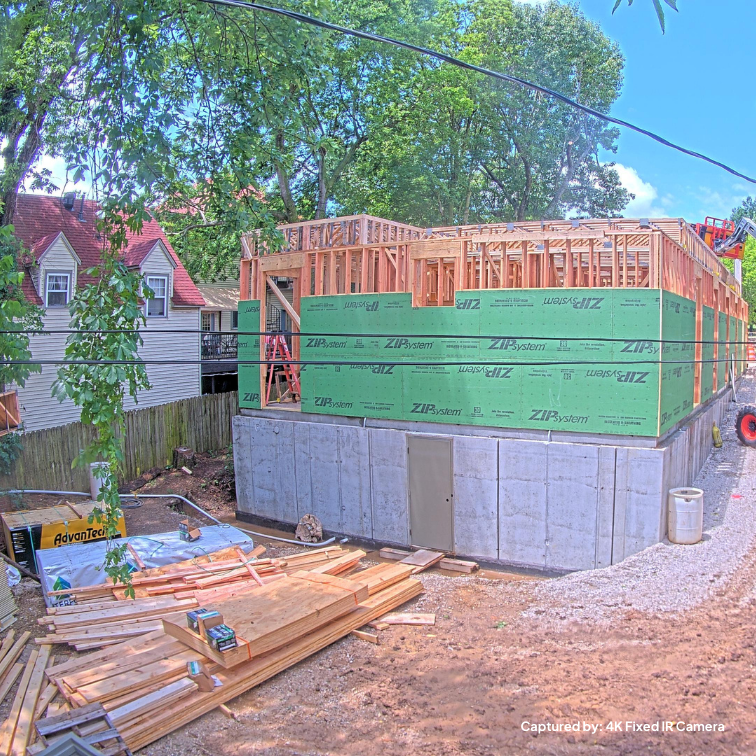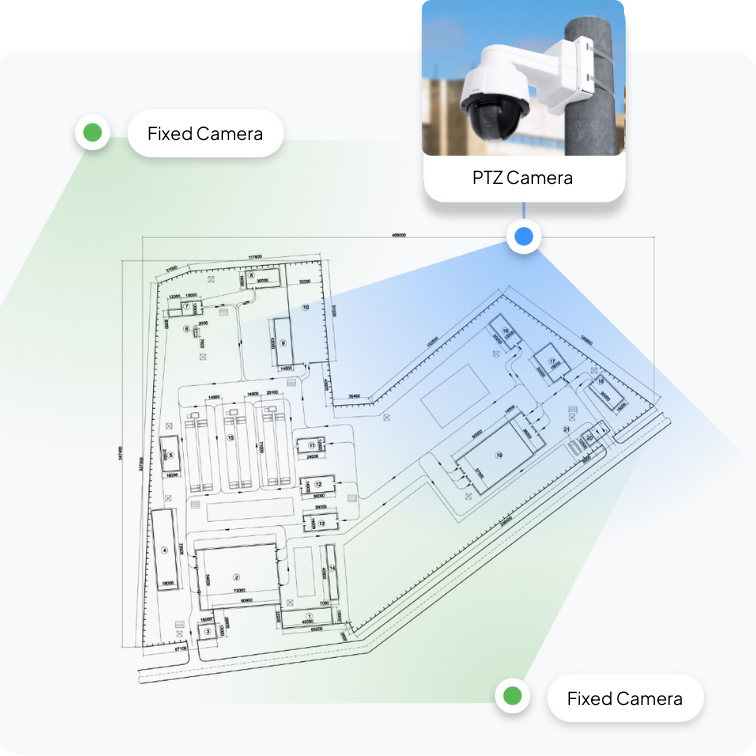When it comes to securing your construction site, the choice between PTZ and fixed cameras isn’t always straightforward, but it’s essential to get it right. Each type of construction camera brings unique capabilities to your security setup, from wide-area surveillance to focused monitoring of critical areas.
In today’s article, we break down what makes each camera unique. We evaluate each camera’s pros and cons, seeing how they stack up against each other.
Understanding PTZ vs. Fixed Cameras
Construction cameras come in two primary options: pan-tilt-zoom (PTZ) and fixed. Each provides a distinct advantage and provides eyes on every project without physically needing to be there.
Here’s a look at what makes these cameras special:
- PTZ Cameras: These cameras can pan, tilt, and zoom for dynamic coverage over a broad field of view. They are best for large areas requiring flexible monitoring, investigative tracking, and active surveillance. Most PTZ cameras allow the user to control the view. Some also have the option to operate on automated security patrols during off-hours for a continuous scan of the whole jobsite.
- Fixed Cameras: Fixed cameras maintain a constant field of view, capturing a specific area. They’re ideal for construction sites that need continuous 24/7 monitoring of entry points, high-risk zones, critical equipment storage areas, and low-visibility areas. Fixed cameras don’t move, but they often offer higher-quality images and more stable time-lapses.


Additionally, TrueLook’s PTZ cameras can generate panoramic time-lapse images, allowing for granular oversight of the entire jobsite’s progress. Both options work well as part of security solutions, such as TrueShield, which also has strobes, sirens, and a talk-down bullhorn.
Key Differences at a Glance
The differences between pan-tilt-zoom cameras and their fixed counterparts may seem negligible, but when deployed in the field, those differences can be monumental. Therefore, those variations define the use cases for each camera, providing specific features that meet your needs.
For example, PTZ cameras offer 360-degree movement, and some have preset views, so you can quickly redirect it to check on key areas. This movement provides a broader field of view, perfect for covering larger areas instead of using multiple cameras.
Alternatively, fixed cameras provide constant, 24/7 coverage of a fixed field of view. That constant coverage is better for high-risk security zones, where even a blink can create surveillance lapses.
Fixed cameras frequently offer a wider field of view for any given angle but are stationary at that one angle. Yet, deploying several fixed cameras can get expensive quickly.
Pros and Cons of PTZ Cameras
PTZ surveillance cameras are versatile, offering a range of movement, including its namesake panning, tilting, and zooming. These cameras are a powerful choice for comprehensive security coverage of large spaces, like material staging yards and multi-story building sites.
While these motorized cameras can replace multiple fixed cameras and provide extensive coverage from a single mounting location, they come with distinct advantages and limitations that security professionals should carefully consider.
Pros:
- Wide Area Coverage: One PTZ camera can provide extensive coverage of large indoor spaces and outdoor spaces, potentially replacing multiple fixed cameras. This broad coverage makes them particularly cost-effective for monitoring vast construction areas.
- Zoom Capabilities: Advanced optical zoom features allow operators to capture high-resolution images of distant objects like license plates. The optical zoom delivers images without distortion and ensures detailed surveillance even from remote mounting locations.
- Remote Control Functionality: Most PTZ cameras offer complete pan, tilt, and zoom control via remote operation.
- Versatility: Many PTZ cameras include programmable patrol patterns with IR night vision capability for 24/7 monitoring. You can adjust the camera’s position to automatically monitor different areas throughout the day.
Cons:
- Limited Field of View at Any Given Moment: Unlike fixed cameras that maintain constant coverage, the movement of PTZ cameras means they can only monitor one area at a time within their field of view. This limitation means there will be potential blind spots when the camera moves.
- Potentially Higher Costs: The motorized components and advanced features of PTZ security cameras make them more expensive than fixed dome cameras or bullet cameras.
- Mechanical Wear and Tear: The pan, tilt, and optical zoom mechanisms are motorized parts, which means they’re prone to breakdowns over time. Because of their moving parts, they may also require more frequent professional maintenance.
Pros and Cons of Fixed Cameras
While fixed cameras, including dome and bullet IP cameras, provide consistent coverage, they cannot pan, tilt, or zoom (via optical zoom) like their PTZ counterparts.

However, they excel at capturing high-resolution footage of specific areas requiring constant monitoring, such as equipment yards and site entrances.
Pros:
- Consistent Coverage: Fixed cameras provide continuous monitoring with a constant fixed field of view. That consistent monitoring ensures that no moment goes unrecorded in the target area. These cameras excel at discreet surveillance, capturing high-resolution images of one set area 24/7.
- Higher Image Quality: Fixed cameras deliver superior image detail and image quality due to their stable mounting location. Without motorized components, they can maintain consistent focus and capture high-resolution footage.
- Lower Cost: Fixed cameras are often more cost-effective than PTZ surveillance cameras because they require less maintenance due to fewer moving parts. Their simple yet robust design makes them an economical choice for security systems, especially when considering long-term reliability.
- Ideal for High-Security Areas: These camera’s field of view stays focused on critical areas, making it perfect for capturing detailed footage of entry points and equipment storage.
Cons:
- Limited Viewing Area: Fixed cameras maintain a single fixed lens view, often requiring multiple fixed cameras for comprehensive coverage. The singular field of view means each camera can only monitor what’s within its viewing angle.
- No Active Tracking: Without auto-tracking features, fixed cameras cannot follow moving objects or adjust to changing surveillance needs. The lack of tracking features means they rely entirely on their initial mounting position to capture activity.
- Requires Strategic Placement: Careful consideration of mounting handle and camera base positioning is crucial to eliminating blind spots and ensuring ideal coverage. Poor placement results in gaps in surveillance, which can compromise site security.
- Low-quality Zoom Options: Many fixed cameras utilize a digital zoom (like a cellphone photo), which offers limited zoom capabilities. Images captured with digital zoom can be blurry when looking at distant objects.
How to Choose Between PTZ vs. Fixed Cameras for Your Site
As you can see, each camera type provides unique advantages (and disadvantages) to meet your security needs. When choosing between PTZ and fixed cameras for your job sites, consider these factors to decide on the most effective surveillance solution:
- Site Size and Layout: Large indoor spaces and extensive outdoor areas benefit from PTZ cameras, while fixed cameras excel in designated security zones requiring constant monitoring.
- Primary Security Concerns: Fixed cameras with high-resolution images are ideal for critical points needing 24/7 coverage. In contrast, PTZ security cameras offer flexible surveillance with 360-degree view capabilities for tracking moving objects.
- Budget Considerations: While multiple fixed cameras provide cost-effective coverage for specific areas, one PTZ camera can potentially replace several fixed cameras for wide area coverage, impacting overall system expense.
Why Many Construction Sites Use Both
While many construction site managers turn to cameras to maximize their security needs, often, their use is a requirement of builders’ risk insurance policies. Many insurance companies mandate the use of multiple cameras to meet minimum security thresholds, and incorporating more of them may even reduce premiums.
A strategic mix of surveillance technology also gives construction teams the best of both worlds. For example, fixed cameras maintain constant watch over critical areas like material storage and entry points. Simultaneously, PTZ surveillance cameras with movement capabilities keep eyes on larger spaces and track site activity.

This dual approach provides the comprehensive coverage that insurance underwriters demand while also giving construction teams the flexibility to monitor their sites through every phase of the project. When using these cameras with other TrueLook Solutions, like TrueDeter, you secure your job sites with a comprehensive solution that meets your security needs.
Select the Right Camera for Your Construction Site Security
Whether you choose PTZ, fixed, or a combination of both surveillance cameras, the key is matching your security solution to your site’s unique requirements and insurance mandates. Today’s construction sites often benefit from both technologies, combining the unwavering watch of fixed cameras with the dynamic coverage of PTZ systems.
Ready to enhance your site’s security? Connect with us at TrueLook to develop a comprehensive camera solution to protect your construction site during every step of your project.

